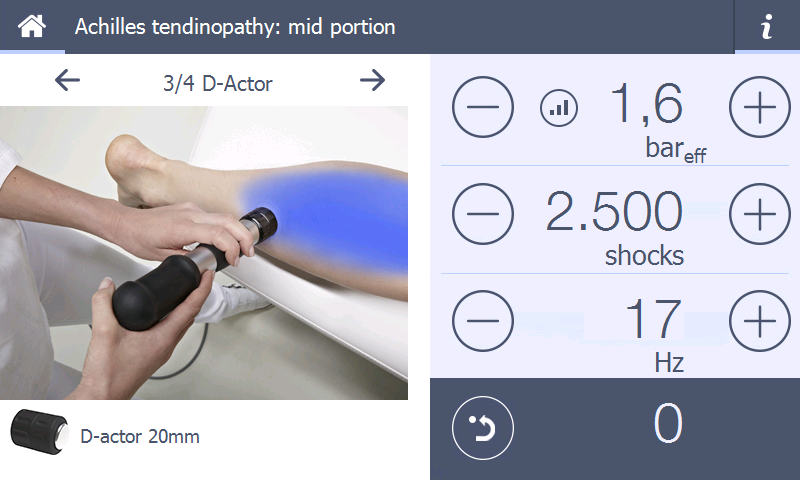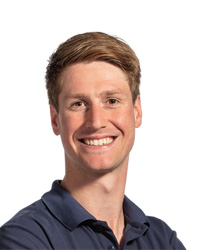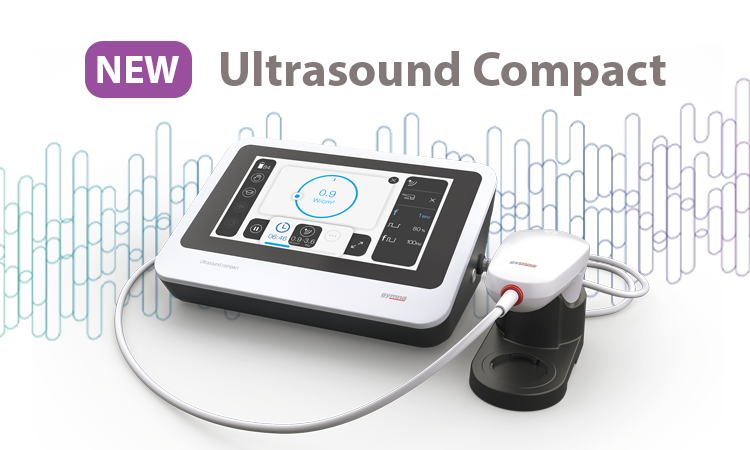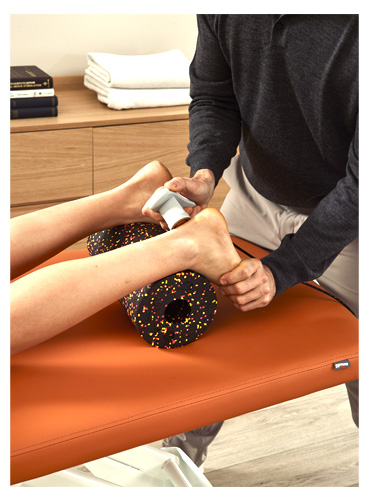Five ways to overcome achilles tendinopathy faster

As a physiotherapist, you often face the challenge of effectively alleviating your patient's Achilles tendinopathy. In this article, we’ll share scientific insights into five powerful physiotherapy techniques and how industrious physiotherapists like Tim and Killian put these techniques into practice. Discover how these experts successfully utilise complementary approaches such as shockwave therapy, ultrasound therapy, laser therapy, TECAR therapy, and percutaneous electrolysis. Learn from their experiences and explore how to integrate these innovative approaches into your practice.
Physiotherapy techniques as supplementary treatment for Achilles tendinopathy
Achilles tendinopathy is a persistent condition that can arise in both athletes and non-athletes. Although the clinical presentation may vary among patients, common denominators include pain, palpable - or sometimes visible - thickening in the Achilles tendon, and limitations to a patient’s daily and athletic activities. The standard care offered by physiotherapists generally includes education, modification of load, and exercise therapy, but sometimes, these types of interventions yield insufficient results. In that case, supplementing your treatments with scientifically supported physiotherapy techniques can be the right move.
Pain relief and healing promotion through Shockwave therapy
Extracorporeal Shockwave Therapy (ESWT) is a non-invasive treatment method in which short, intense sound waves activate the body's natural healing processes. Pain relief and accelerating the body’s healing properties are the focal point of this treatment modality. Radial shockwave (rESWT) has been used to treat chronic tendon issues since the beginning of this century. Currently, the scientific consensus favours this treatment's effectiveness, particularly regarding Achilles tendon tendinopathy.

A systematic review by Stania et al. (2019), including only high-quality RCTs, yields a positive conclusion. Following a minimum of three treatments, the percentage of patients fully recovered or significantly improved four months after the last intervention is 52% for patients with a mid-portion tendinopathy and 64% for patients with an insertional tendinopathy. When combining radial shockwave therapy (2000 pulses, 8 Hz, 3 sessions) with eccentric loading, the percentage of patients reporting significant improvements or a full recovery increases to 82%.
 Physiotherapist Tim, specialising in lower extremity issues and a proud novice user of the Gymna ShockMaster, can only agree with this success rate:
Physiotherapist Tim, specialising in lower extremity issues and a proud novice user of the Gymna ShockMaster, can only agree with this success rate:
"I work in a sports, youth, and family practice and regularly see patients with Achilles tendinopathy. Shockwave is never a standalone intervention for my colleagues and me, we tend to use shockwave during every treatment. Approximately 75% of our patients with Achilles tendinopathy are (largely) recovered after about five treatments."
Tim also speaks highly of the ShockMaster itself:
"I make extensive use of the Guided Therapy System that the ShockMaster is equipped with. Because this system is evidence-based, the patient automatically receives the shockwave treatment with the best support. Additionally, it's great that the ShockMaster automatically adjusts the parameters to optimise treatments with different treatment heads."
Enhanced tissue healing phases through Therapeutic Ultrasound therapy
Ultrasound therapy is a safe and non-invasive treatment modality employing high-frequency sound waves to reduce pain and improve function. Ultrasound enhances the efficiency of all tissue healing phases, making it widely applicable for Achilles tendinopathy.
Dedes et al. (2020) compared ultrasound with shockwave therapy and found significant improvements in pain and function with both techniques, although the effect of shockwave was significantly greater. However, the principal advantage of ultrasound lies in its accessibility. Overall, many therapists have access to an ultrasound therapy device, and integrating ultrasound therapy into treatment usually comes with no extra charge for the patient. Moreover, patients generally tolerate this type of therapy very well. Therefore, ultrasound is a suitable alternative if shockwave is unavailable or not tolerated by the patient.

Stimulation of metabolic cell activity through Laser therapy
Laser therapy is a non-invasive treatment method that increases metabolic activity in cells, thereby stimulating their self-healing capacity. This leads to a better and faster recovery and contributes to pain reduction. Low-level laser therapy (LLLT) can efficiently treat Achilles tendinopathy.
Studies by Stergioulas (2008) and Tumilty (2010) fully support the positive effects of laser therapy. Stergioulas concludes that combining LLLT with an eccentric exercise program further accelerates a patient’s recovery. Delivering the right amount of energy is essential to achieving a good result. That is where the Walt table comes into the picture, as it is the perfect tool to determine the correct amount of energy for a specific parameter for multiple conditions.
Improved blood circulation and pain relief through TECAR therapy
 TECAR therapy is a non-invasive electrothermal therapy classified as deep thermotherapy. Unlike superficial thermotherapy, TECAR generates heat in deeper tissues, increasing haemoglobin saturation. According to Bito et al., that is precisely what happens when TECAR therapy is applied in the peritendinous area of the Achilles tendon. Additionally, TECAR improves blood circulation, vasodilation, lymphatic effects, and cell proliferation, providing the ideal conditions for the repair of tendon tissue.
TECAR therapy is a non-invasive electrothermal therapy classified as deep thermotherapy. Unlike superficial thermotherapy, TECAR generates heat in deeper tissues, increasing haemoglobin saturation. According to Bito et al., that is precisely what happens when TECAR therapy is applied in the peritendinous area of the Achilles tendon. Additionally, TECAR improves blood circulation, vasodilation, lymphatic effects, and cell proliferation, providing the ideal conditions for the repair of tendon tissue.
TECAR is rarely used as a standalone therapy in the treatment of tendinopathy. In general, physiotherapists combine TECAR with techniques targeting the chronic phase. That is why percutaneous electrolysis or shockwave therapy are ideal companions for eccentric exercises and TECAR therapy.
Activation of natural healing mechanisms through Percutaneous Electrolysis
Percutaneous electrolysis is a relatively new but minimally invasive technique that entails inserting a thin needle into the treatment area under ultrasound guidance. A direct current is then applied through this needle, thereby inducing a non-thermal electrochemical reaction. Its intended effect is the activation of the body’s natural healing mechanisms.
Percutaneous electrolysis for tendinopathies and plantar fasciitis shows promise but needs further confirmation on a larger scale. Silva et al. (2014) claim that this type of treatment method reduces pain in Achilles tendinopathy patients and improves their functional movement. Ronzio et al. (2017) also observed pain reduction, increased ankle range of motion, and decreased morning stiffness in patients in the experimental group compared to patients in the control group.
 Physiotherapist Killian is also convinced of the benefits of percutaneous electrolysis:
Physiotherapist Killian is also convinced of the benefits of percutaneous electrolysis:
"With percutaneous electrolysis, you can work precisely at the affected location, which makes the treatments I carry out very accurate. Moreover, this particular technique can be seamlessly integrated into my treatments thanks to its short intervention duration. I use the Gymna Acure 250 device, which is particularly intuitive and requires only a short learning curve to implement this type of treatment."
Applying physiotherapy techniques in your practice
Physiotherapy techniques can significantly contribute to your patient's recovery from Achilles tendinopathy. These techniques provide you, as a physiotherapist, with additional options to support these patients and those with other pathologies more effectively in their journey towards an injury-free body.
Are you considering expanding your practice with new techniques? All the physiotherapy techniques discussed in this blog are available in our state-of-the-art equipment range, with user-friendliness being our top priority. If you have any questions about our offerings, please get in touch. We'd happily advise you on the technique that suits you and your practice perfectly.
